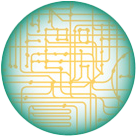Amphiphilic Cosolvents Disrupt the Lateral Structure of Model Biomembranes and Reveal an Unrecognized Mode of Cell Stress
Authors:
Jonathan D. Nickels1* ([email protected]), Luoxi Tan1, Micholas Dean Smith2,3, Haden L. Scott3, Sai Venkatesh Pingali3, Hugh M. O’Neill3, Jennifer Morrell-Falvey3, John Katsaras3, Jeremy C. Smith2,3, James G. Elkins3, Brian H. Davison3
Institutions:
1University of Cincinnati–Cincinnati; 2University of Tennessee–Knoxville; 3Oak Ridge National Laboratory
URLs:
Goals
This Science Focus Area is developing fundamental knowledge about the ways that solvents change the structures of plant cell walls and microbial membranes. The team’s overarching hypothesis is that the partitioning or binding of solvent molecules from the bulk phase to biomass or biomembranes will predict maximal or minimal disruption. Disruption of biological structures comprised of amphiphilic molecules and polymers (e.g., membranes and biomass) is a key step in biomass pretreatments and engineering the ultimate microbial limits in tolerating specific solvents. Researchers integrate the power of world-class neutron scattering capabilities and leadership-class supercomputing facilities available at Oak Ridge National Laboratory (ORNL). These capabilities are complemented by expertise in biodeuteration and biomembranes at ORNL, plant cell wall chemistry at the University of Tennessee, and neutron scattering and membrane biophysics at the University of Cincinnati.
Abstract
Fuels and value-added chemicals derived from sustainable lignocellulosics are an important part of realizing the future circular bioeconomy. This requires efficient production of biointermediates, including ethanol or n-butanol, which have chaotropic effects on biomolecules leading to their toxicity to fermentative microbes. While these toxic effects can impact many macromolecules, the cellular membrane is especially vulnerable to disruption due to the partitioning of amphiphilic cosolvents into the lipid bilayer. This leads to well understood impacts on the transverse membrane structure at high cosolvent titers—membrane thinning, destabilization, loss of membrane potential, and eventually, cell death. The effects on lateral biomembrane structure have been less well studied, however. Lateral membrane organization can be understood in analogy to an in-plane phase separation of high and low melting point lipid species, as well as sterols (or their microbial analogs). This results in local membrane regions with different membrane compositions and physical properties. In the biological context, these structures are known as functional membrane microdomains or lipid rafts. Rafts play an important role in many cellular processes due to their role as platforms to sort, colocalize and assemble membrane proteins.
Researchers propose the hypothesis that amphiphilic cosolvents, such as ethanol and n-butanol, alter or disrupt functional membrane microdomains, leading to an unrecognized mode of cosolvent toxicity and cellular stress at cosolvent concentrations, far lower than those which induce membrane disruptions. To support the investigations, researchers developed novel neutron scattering and MD simulation strategies to experimentally observe the nanoscale changes in membrane structure in living cells.
Researchers demonstrated the direct disruption of a model lipid raft due to the presence of the amphiphilic cosolvent ethanol and elucidated the physical mechanism for the lipid domain disruption (Tan et al. 2023). Subsequently, n-butanol was observed to be more potent in disrupting membrane organization. Researchers have measured an unequal partitioning of n-butanol between the coexisting phases, leading to an increased mismatch in the hydrophobic thickness of these phases, confirmed by neutron-scattering observations. This leads to an increase in the domain line tension, which is a driver to minimize the domain interface-to-domain area ratio. These observations are complemented with large scale simulations replica lipid domain which molecular details about n-butanol partitioning and induced changes to the lipid domain interface.
Researchers also performed SANS measurements and extensive all-atom simulations on the partitioning of amphiphilic cosolvents (ethanol/THF/n-butanol) in living cell membranes and cell membrane extracts. The team showed direct measurements of cell membrane thinning in living Bacillus subtilis in the presence of these cosolvents using neutron scattering, estimated the true partition coefficient of these cosolvents, and interrogated the role of fatty acid supplementation in modulating the cellular response to these solvents. This work represents the first systematic approach of the nanoscale membrane phenotype in fermentative microorganisms. Further validation of this hypothesis will provide a more holistic understanding of solvent–membrane interactions and will inform strategies to improve cosolvent tolerance.
References
Tan, L., et al. 2023. “Amphiphilic Co-Solvents Modulate Structure of Membrane Domains,” ACS Sustainable Chemistry & Engingeering DOI: 10.1021/acssuschemeng.2c06876.
Funding Information
This research is supported by the DOE, Office of Science, through the Genomic Science Program, BER program, under FWP ERKP752. Oak Ridge National Laboratory is managed by UT-Battelle, LLC for the DOE under contract no. DE-AC05-00OR22725.
